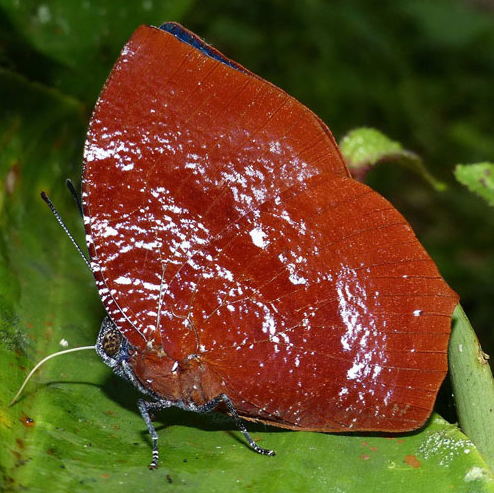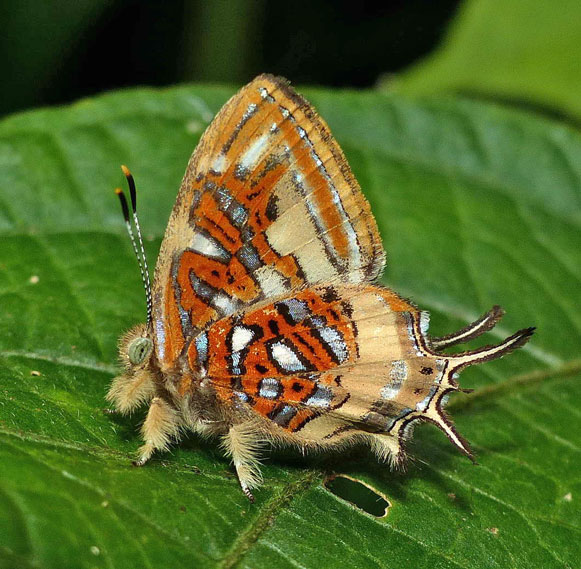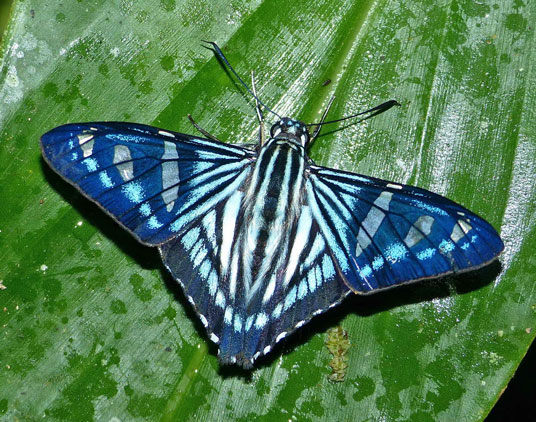

Colombia is one of the most butterfly rich countries on the planet, with roughly 3800 species, about 20% of the earth's total. On this tour we won't see all of the species, but we'll see an awful lot! This trip explores beautiful areas in the west-central portion of the country.
We retain the right to remain flexible as to our exact itinerary in order to take best advantage of hot spots and to enable us to work with the weather, not against it. Exactly where and when butterfly populations will appear is highly dependent upon local environmental and climatic conditions. The uncertainty heightens our excitement.
Day 1. We arrive in Bogota, this evening, staying at a very comfortable hotel near the airport.
Day 2. Today, we take advantage of Bogota’s location on a high plateau, and head off to the Parque Natural Chicaque, just over an hour’s drive to the west. Here, at the plateau’s edge at around 8500 ft. (2600m) elevation, we’ll get a good introduction to the upper montane Andean fauna of Colombia. From the main entrance, we descend to a great overlook with a spectacular sweeping panoramic view of the Magdalena Valley, with lots of blooming flowers around the brick walkway. We may see several hairstreaks, including the gorgeous Ruddy-frosted Andean-Elfin (Penaincisalia loxurina), with its brick-red underside dappled with white scales, pretty green-vented dreamstreak (Erora) species, and the unusual tail-less Frosted Andean-Elfin (Rhamma arria). A number of skippers hilltop here, especially species of skipperlings, such as the white and yellow patched Ochre Skippering (Dalla polycrates) and, if we are lucky, we may also see Boldly-marked Therra (Thespieus othna) with its spectacular, contrasty underwings. Other sun-basking species we hope to see include several dartwhites (Catasticta) including, if we are lucky, the yellow and red patched Underwing Dartwhite (Catasticta uricoecheae), plus the pretty salmon-pink and blue-spotted Brazilian Lady (Vanessa braziliensis) and the silver-patched Andean Silverspot (Dione glycera). On the nearby trails we’ve seen some pretty satyrs, including chestnut and yellow patched Burnt-orange Ocellated-Satyr (Eretris apuleja), the endemic white-spotted Eagle-head Pedalio (Pedaliodes pylas), and the glorious Oval-spotted Falcon-Satyr (Corades chelonis) with its rich reddish-orange upperside. When things quite down, we’ll head back to the main entrance, where we’ll have a tasty hot chocolate or coffee in the restaurant while we watch hummingbirds and llamas!
Day 3-4. An early morning flight brings us to Pereira. After meeting up with our van and driver, we will head east to visit a cloud forest reserve where we will bait along a vehicle track that extends for several kilometers through delightful forest at around 6000 to 7000 feet (1900-2100m). We hope to see many stunning species but the highlight must include the remarkable Elzunia (Elzunia) species) – they are large, entirely opaque, and very colorful. No less than three of the four known Elzunias fly here: Colombian, Common and Regal Elzunia (E. bomplandii, E. humboldt, and E. regalis). These were only recently believed to represent a single species. We also hope to see a couple of elegant species of leafwing: Druce's Leafwing (Anaea lyceus) and the magnificent falcate-winged Dark-lined Leafwing (A. pasibula). For some wonderful eye-candy you can’t do much better than the distinctive and endemic Blue-patched Crescent (Eresia levina), which leaves you wondering which of the two wing surfaces is the more attractive. More conventional, but still eye-catching species include Short-lead Eighty-eight (Diaethria euclides), Broad-banded Pericloud (Perisama yeba), Banded-brown Heliconian (Podotricha judith), Variable Prestonian (Tithorea tarricina), and Spartan Patrician (Patricia dercyllidas). If we are lucky we may find rarely seen deep-forest specialists such as Adopted Morphet (Antirrhea adoptiva) and Two-striped Owl-Butterfly (Eryphanis zolvizora), while in the same habitat, Orange-banded Phantom-Satyrs (Pseudohaetera hypaesia) are common and will wow us with their delicate and stealthy flight. Blue-patched Satyrs (Mygona irmina) float daintily down the track, while Whitechain Oxeos (Oxeoschistus puerta) are more determined flyers. Owl-eyed Eyemark (Mesosemia metuana) provide a welcome splash of exotic blue, while it will be great to see flamboyant pierids such as Yellow-rayed Mimic-White (Dismorphia lewyi), Yellow-ringed Leowhite (Leodonta tellane), and Lucas' Greeneyed-White (Leptophobia caesia). If we are fortunate we will see the spectacular endemic Colombian Beamer (Phocides perillus), and also White-bordered Firetip (Pyrrhopyge aziza).
Nights near Pereira at a comfortable on-site birder’s lodge, set in attractive gardens bordered by cloud forest.
Days 5-7. After a final half day at our Pereira site, we move on westwards to our wildest and most species-diverse forest in Tatamá National Park, presenting us with opportunities to see a large selection of highly specialized Pacific slope (Chocó) endemics and species not found elsewhere in the Andes or in the continental lowlands to the east. This area has a unique characteristic in that these Chocó species come from the Pacific forest up the valley of the San Juan River, where they mix with the fauna of the western Andean Cauca River valley. This leads to greatly increased species diversity – over 700 species have been photographed here - and in the case of species with many local races, creates a genetic melting pot in this zone of hybridization – and so we see some unusual and beautiful forms, such as those produced by the mixing of two subspecies of Grinning Heliconian (Heliconius cydno). The forest here is beautiful, and the unpaved vehicle track allows us access across a broad spectrum of cloud forest habitat from lower montane at 4000 feet (1300m) to upper montane at around 7,500 feet (2300m). All of the species that are listed below are beautiful and in many cases they are rare elsewhere, but we have a good chance to find them or lure them to our bait. There are many stunning skippers, such as Bell's Beamer (Phocides metrodorus), Brilliant Firetip (Chalypyge zereda) and Chocolate-vented Mytip (Myscelus perissodora). Swallowtails are scarce, but Colombian Kite-Swallowtail (Eurytides columbus) is an especially notable species we may see. Whites and yellows are well represented, especially the Mimic-Whites, amongst which the pretty and endemic Colombian Mimic-White (Dismorphia altis) stands out. Many glittering metalmarks will beguile us with their dazzling colors, amongst them Yellow-banded Eyemark (Mesosemia pacifica), Blue-bordered Metalmark (Necyria bellona zaneta), Studded Jewelmark (Anteros roratus), and Neglected Jewelmark (Sarota neglecta), and if we are especially lucky we may see Blue-and-orange Maskmark (Argyrogrammana leptographia) and the breath-taking Aphrodite’s Bandmark (Lucillella aphrodita). The hairstreaks are always wonderful treats, and a number of spectacular rarities have been seen here, including White-W Greatstreak (Paiwarria episcopalis) and Colombian Greatstreak (Airamanna columbia). The charaxines are present in good numbers, and include some real stunners such as White-spotted Agrias (Agrias amydon), Black-fronted Leafwing (Consul panariste), while the giant Fire-rimmed Leafwing (Anaea laura) will excite us with its maroon-colored wings. Let’s also hope we are lucky and see the dramatic Red-patched Leafwing (Siderone syntyche), and the rare Chocó endemic Many-banded Prepona (Prepona werneri). Although it looks rather like a satyr, the Scalloped Morphet (Antirrhea undulata) is a remarkable species we hope to find skulking around in deep vegetation. If we are fortunate, we may chance upon a plate-sized puddling male of the high-flying Short-tailed Morpho (Morpho theseus) or lure to our bait the exquisitely marked Lilac-banded Owl-Butterfly (Caligo oberthurii). There are many unusually pretty satyrs here, amongst which are Rusted Phantom-Satyr (Cithaerias pireta), Luna Phantom-Satyr (Pierella luna) and Mimic Phantom-Satyr (Pseudohaetera mimica). Among the transparent ticlears, Orange-bordered Oleria (Oleria amalda) stands out for its gorgeous colored border, and Yellow Oleria (Oleria zelica) for its unusual black and yellow design. Your tour leader will naturally be keen to find and show you his eponymous Colombian Banner (Epiphile neildi) with its vibrant violet bands. We also hope to spot the strikingly-marked Striped Eighty-eight (Callicore atacama), and old favorites such as the gaudy Blue-bordered Panacea (Panacea procilla).
Nights in a simple but pleasant hotel in the small town of Pueblo Rico – and a chance to mix with the friendly and hospitable locals, and to enjoy tasty food at the restaurant next door.
Day 8. We will revisit our preferred sites this morning before heading off after a late lunch to our comfortable hotel with outstanding views on a bluff overlooking the Cauca river valley near La Pintada.
Day 9. Today we'll make a day trip to a lower cloud forest site to the southwest of Manizales at around 6000 feet (1800m). We'll spread bait along promising stretches of road, and hope for a variety of visitors including eye-catching favorites such as Common Morpho (Morpho helenor), Pink-celled Leafwing (Anaea nessus), and purple and pink flushed banners such as Blue Banner (Epiphile epimenes) and Pink-striped Banner (E. dilecta). Elegant Stormy Heliconians (Heliconius clysonymus) are always crowd-pleasers, while numbers of glistening Lamplight Actinote (Altinote ozomene) are great subjects for photography, and pretty Orange-edged Daggerwing (Marpesia corinna) usually clump in conveniently aesthetic groups. Less common species include the giant Almond-celled Owl-Butterfly (Caligo oileus), and the skittish pink-tongued Brown Prepona (Noreppa chromus). More frequently encountered species but no less attractive include White-striped-blue Eyemark (Mesosemia mevania), which flits around leaves above stream banks, pink-banded Small-disked Actinote (Altinote callianthe), and the common, but beautifully marked, Doubleday's Crescent (Eresia carme). The large Staudinger's Leafwing (Anaea pseudiphis) might put in an appearance, and hopefully will bask for us with its glorious blue upper wings wide open, and likewise Narrow-banded Banner (Epiphile iblis) with its pink and blue flushed uppers is an exquisite species we are likely to encounter. Once again we will probably find Grinning Heliconian (Heliconius cydno), but in yet another distinct subspecies from sites we have visited previously. Various montane satyrs include the Big-eyed Ocellated-Satyr (Eretris calisto). We can also hope for some colorful metalmarks such as Giant Jewelmark (Anteros kupris) and the extraordinary Black-legged Jewelmark (Ourocnemis archytas), and perhaps some fantastic hairstreaks such as Humped Elstreak (Laothus gibberosa), Fractured Highstreak (Micandra platyptera), and Dark Cross-streak (Panthiades paphlagon).
In mid-afternoon, we’ll drive east to overnight at a very comfortable hotel at Rionegro.
Day 10. Today we’ll head east through the typical Colombian scenery of the Central Andes - mountainsides punctuated by waterfalls and coffee plantations, steep forested gorges, and long vistas down lush green valleys - towards the Magdalena Valley foothills. Here, in the Río Claro area, we'll find our second most diverse butterfly community of the trip in tropical rainforest at our lowest-elevation sites. Today we’ll visit a forested river valley at around 2500 feet (750m) about an hour from our hotel, to explore the river banks and immediate area where we are likely to see plenty of species including the gorgeous Cherry-bordered Metalmark (Lyropteryx lyra cleadas) and Blue-and-yellow Beautymark (Ancyluris inca), dazzling Black-topped Blue-Skipper (Pythonides proxenus), eye-popping eighty-eights such as Two-eyed Eighty-eight (Callicore pitheas) and Six-spotted Eighty-eight (Callicore lyca), and we may even turn up some swallowtails such as Emerald-patched Cattleheart (Parides sesostris), Heliconoid Swallowtail (Mimoides pausanias), and Dual-spotted Swallowtail (Mimoides ilus).
We'll arrive in the late afternoon at our pleasant country hotel near Río Claro (complete with necessarily air-conditioned rooms in this tropical climate!). Bring your swimming suit – the hot tubs are fab, and the outdoor pool is really warm (about 85°F / 30°C) - and you can watch parrots flying overhead as the sun sets while you laze on your back! The pool is hedged-in by bushes of red-flowered Ixora, highly attractive to swallowtails and sulphurs, as well as to the occasional gossamerwing such as the large Confusing Scrub-Hairstreak (Strymon megarus). Oh, and watch out for the giant green iguanas that amble through the gardens! Night near Rio Claro.
Days 11-12. We will spend these two days exploring the lowland tropical forests of the humid Magdalena River Valley at around 1000 feet elevation (400 metres). The Rio Claro Canyon is a protected area and holds extensive pristine forest, this being the richest area we will visit. Some people will be surprised at the exciting variety of skippers (no, they're not all common, small, and brown!) including several flashers (Astraptes), ghost-skippers (Phanus), Nervous Skipper (Udranomia kikkawai), the glittery Green-headed Sootywing (Gorgopas chlorocephala), and several firetips such as the striking Orange-spot Firetip (Aspitha leander), Narrow-winged Firetip (Zonia zonia), Common Mytip (Myscelus amystis), and Teal-bordered Firetip (Passova ganymedes). And yes, there are pretty grass-skippers around too, such as Dyson’s Silverpatch (Aides dysoni), Blue-costa Skipper (Aroma aroma), Superb Ruby-eye (Carystus superbiens), Squiggly Brown-Skipper (Phanes aletes), and the glowing Teal Saliana (Saliana hewitsoni) - all of these are usually found in the interior of good forest. Other forest treats include some surprising metalmarks – Flame-bordered Sheenmark (Eurybia donna), Blue-winged Sheenmark (E. lycisca), and Four-spotted Mimic-mark (Pheles strigosa) like to hide their beauty under leaves, while White-patched Metalmark (Cyrenia martia) and jewelmarks such as Elegant Jewelmark (Anteros allectus), Neglected Jewelmark (Sarota neglecta) and Black-spot Jewelmark (S. acantus) are also wonderful little finds. Smooth Sombermark (Euselasia candaria) and Schaus’ Sombermark (E. tarinta) are glowing little pendants that also like to perch under leaves. And of course, the forest interior is home to larger satyr-types including the stunning Gold-bordered Owl-Butterfly (Caligo atreus), the transparent Rusted Phantom-Satyr (Cithaerias pireta), and the pretty leaf-litter-hopping Red-washed Phantom-Satyr (Pierella helvina). A final reward in lush rainforest are ticlears, potentially including Cell-barred Ithomia (Ithomia diasa) and Fuzzy-spotted Ticlear (Hypoleria lavinia). We'll also explore more open areas, looking for large species such as Tigerwing Swallowtail (Papilio zagreus), daggerwings (Marpesia), the flashy Spot-celled Emperor (Doxocopa clothilda), dazzling Thick-rimmed Sailor (Dynamine chryseis), amazing Black-bordered Daggerwing (Marpesia furcula), and other tropical brushfoots such as Flaming Panacea (Panacea prola), Stub-tailed Purplewing (Eunica orphise) and Blue-and-orange Eighty-eight (Callicore tolima). There are also nearly unlimited options for great hairstreaks like Costa Rican Cycadian (Eumaeus godartii), Ochre Groundstreak (Calycopis trebula), and Black-barred Cross-streak (Panthiades phaleros).
There is one side road that has been particularly productive in the past: on a short stretch of it we have recorded Costa-spotted Beautymark (Ancyluris jurgensenii), Felder’s Scintillant (Crocozona pheretima), Orange-barred Pixie (Melanis electron), White-fringed Lemmark (Synargis calyce), Blue-and-white Heliconian (Heliconius sapho), Yellow Patch (Chlosyne narva), Splendid Crescent (Eresia emerantia), White-banded Morpho (Morpho cypris), Blue-celled Purplewing (Eunica volumna) and Many-eyed Sailor (Dynamine arene) – among others!
Finally, we cannot ignore the gardens of our hotel! Among the beauties we've seen here are Cloudy-eyed Whitemark (Leucochimona lagora), Orange-patched Eyemark (Perophthalma tullius) (two wonderful metalmarks!), different forms of Dot-bordered Heliconian (Heliconius doris), and Starry Cracker (Hamadryas laodamia). In short, there is no way we will run out of butterflies to look for in a three-day stay - this is an area with enormous potential!
Nights near Rio Claro.
Day 13. This morning we will revisit our favorite site from the past three days, and after a late lunch head south to Honda, where we overnight in our pleasant colonial hotel, built in 1780, with its central patio, and inviting pool.
Day 14. Today we visit the Bella Vista reserve near Victoria, where there are a number of trails through humid tropical forest at around (3000 feet) 1000 m. Although we are likely to see many species that are typical of the lower Magdalena valley such as we saw in the Rio Claro area, we will also see many additional species that are more commonly encountered above those lower elevations. We hope to see the spectacular Imperial Sunstreak (Arcas imperialis), at least two greenmark species including the rainbow-colored Brilliant Greenmark (Caria mantinea), a couple of glowing metalmarks such as Black-Patched Bluemark (Lasaia agesilas) and Cyan-bordered Hemmark (Nymphidium mantus), several sailors such as Paulina’s Sailor (Dynamine paulina), stunning green and blue Common Olivewing (Nessaea aglaura), transparent Red-tipped Phantom-Satyr (Haetera macleannania), green banded Bold-lined Leafwing (Anaea cleomestra), some pretty ticlears such as Cell-spotted Slantcell (Napeogenes stella), and outlandish skippers such as the see-through Grand Ghost-Skipper (Phanus grandis) and electric blue-banded High Beamer (Phocides pygmalion). Overnight in our hotel in Honda.
Day 15. On this our final day in the field, we need to return to Bogotá. However we will break our long return journey with a stop at a picturesque lake in cloud forest at around 5000 feet (1400m) for our final hurrah. This little oasis of preserved forest will provide us with a nice sample of the local species, including the spectacular red-patched Rayed Sister (Adelpha lycorias), delightfully contrasty Waiter Daggerwing (Marpesia zerynthia), purple-spotted Globed Purplewing (Cybdelis mnasylus), and the large orange-banded Cloud-forest Catone (Catonephele chromis). Both the Turquoise Emperor (Doxocopa laurentia) and Mexican Silverspot (Dione moneta) will dazzle us with their metallic reflections, while the Curvy-veined Greta (Greta andromica) will impress us for the opposite reason – it has almost entirely transparent wings. The Bandaged Satyr (Oressinoma typhla) is remarkable for its dainty zig-zag banding, while the Black Swallowtail (Papilio polyxenes) will remind us of our back-yard swallowtails. The pierids are well represented, noteworthy examples being Kollar’s Surprising-White (Pereute leucodrosime) which looks like a large Actinote, and the exquisitely patterned Dyson's Leowhite (Leodonta dysoni). Perennial favourites include the glorious Pink-C Beautymark (Rhetus dysonii) and dainty Interrupted Stripe-streak (Arawacus leucogyna), while skippers such Red-scarfed Firetip (Pyrrhopyge decipiens) and Tomato-studded Skipper (Noctuana haematospila) finish off the line-up.
We will finish the tour at the same very comfortable airport hotel where we stayed the first night – you can shower and prepare for your flights home late tonight, or tomorrow morning, if you prefer to relax and spend a leisurely final evening.
Day 16. The trip ends this morning at the Bogota airport.
Leader will be Andrew Neild, experienced Neotropical butterflying tour leader.
Cost of the trip is $5295/person from Bogota. Cost includes double-based accommodations, all meals and soft drinks (except for the first night, due to staggered arrival times), ground transportation, airport transfers, tour leader fees and entrance fees. Not included are alcoholic beverages, laundry services, and other items of a personal nature. Single supplement is $495. This trip is limited to 8 participants.
Click Reservations for a Reservation Form.

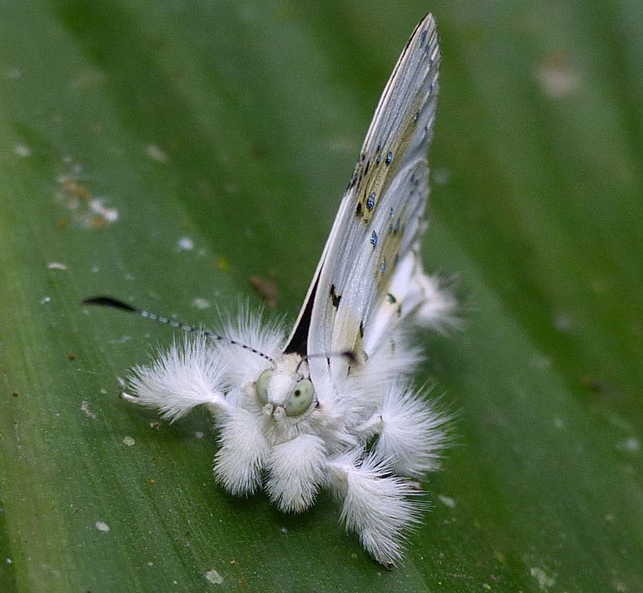
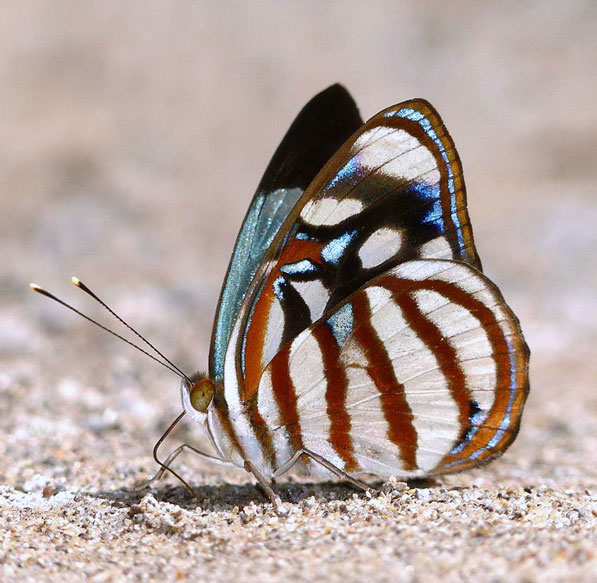

Thick-rimmed Sailor
(Dynamine chryseis)


Sunstreak Tours home page Tour Calendar Tours by Region
West-central Colombia
Sat. January 21 to Sunday February 5, 2023
